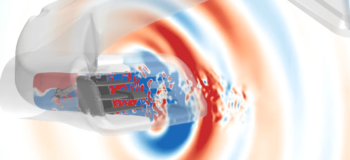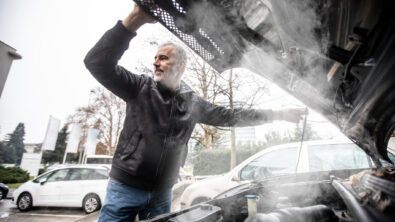Thermal Cabin Comfort CFD – cool stuff to stay hot
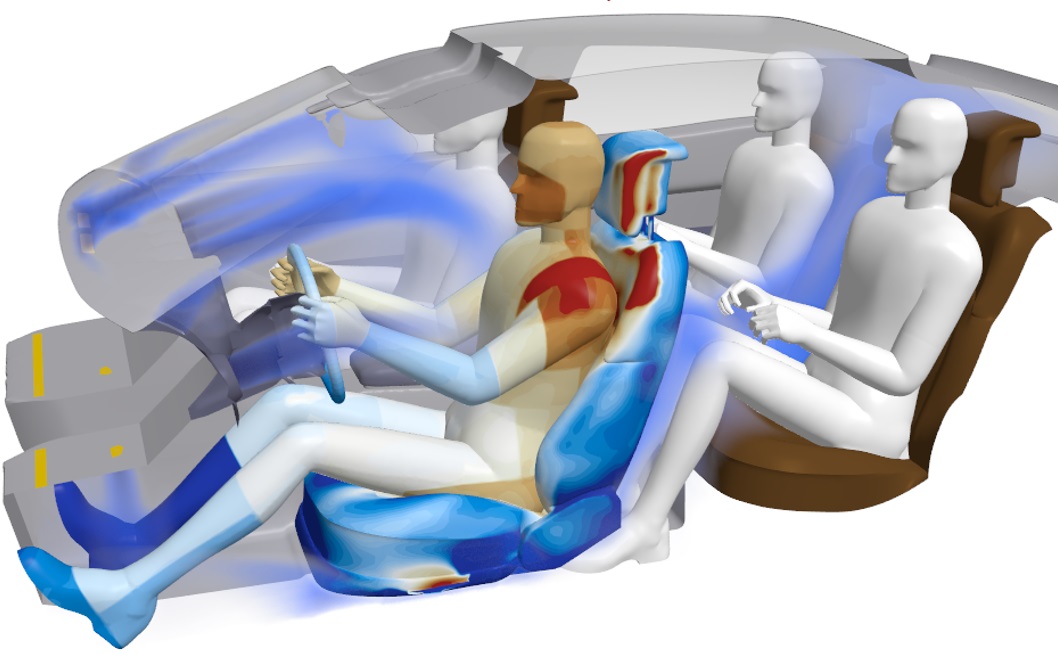
Show me your HVAC habits and I’ll tell you who you are
Any HVAC engineer.
According to the ASHRAE 55 standard (published by the American Society of Heating, Refrigerating and Air-Conditioning Engineers) thermal comfort is defined as “the condition of the mind that expresses satisfaction with the thermal environment”.
Well let me tell you a little anecdote about the “condition of the mind”, when an Italian living in Barcelona visits an office in Texas.
It’s a mind game, they said.
One of the last business trips I went on took place in Texas, during the month of September. It was a particularly good trip as I finally got to do two things I have been looking forward to for a long time.
Firstly, I got to meet many of my teammates from across the globe in person and sit together in the same room. Yes, a proper office meeting room with a very long desk and a giant TV, remember those? Secondly, I got to try the authentic Texas style smoked brisket. Both experiences positively exceeded my already high expectations and made me fly back home to Spain happier than usual, albeit a couple of kilos heavier than when I took off, just a few days earlier.

Another aspect of this trip that totally surprised me was the temperature deltas between the outside and the inside of offices-hotels-restaurants and car cabins. While on the huge (for European standards) parking lots, the hottest summer on record was sadly in full swing, as soon as I entered any building or car it suddenly felt, for me at least, like a mild spring day in Scandinavia (16 C or 60 F give or take).
The even more interesting thing, only to me probably, was to observe throughout the days how each person in the room reacted to the room’s thermal conditions. My subjective “condition of the mind”, under those Air-Conditioning (A/C) settings, was pretty much only expressing regret to not have packed a warmer sweater. However, other colleagues were either partially or fully satisfied despite wearing lighter clothing than myself.
At this point, it was very clear to me how I had to spend the time on my flight back to Europe. No, it wasn’t watching an Avengers movie, but rather open Simcenter STAR-CCM+ 2310, seamlessly couple the newly developed human comfort models into my cabin thermal management simulation and somewhat, better understand the condition of my own mind (maybe?).
Under your skin
In my professional career I had the privilege to work alongside numerous bright engineering teams and help them develop cutting edge thermal and fluid dynamics solutions for a wide range of applications. I therefore thought that, when it came to adding humans and the calculation of skin temperatures into an already very complex multi-physics virtual model, it was just another couple of sets of simple heat transfer equations. Needless to say, I very soon realized that I underestimated the task, to say the least.

The human body is, in itself, an extraordinarily complex system. Predicting its responses to environmental changes requires multiple sub-models and a tight coupling with the flow, energy and radiation solvers. Hence, a human heat transfer and temperature regulation model was proposed by Fiala et al. Int J Biometeorol (2012) 56:429-441 in 2011 – and thanks to its fidelity remains state-of the art until today. The model is able to asses skin temperatures on a manikin level, provided that the body is segmented according to a specific convention (i.e., head, thorax, arms, legs etc.). The Fiala model comprises many key sub-models employed to solve bioheat transfer equations, metabolic heat production and blood circulation physics. In addition, a separate sub-model takes care of computing the heat exchange with the environment throughout the body matrix. Both the influence of the fluid side (i.e., air conditioning, radiation from radiant heaters) as well as the solid side (i.e., heated seats, heated steering wheel) are accounted for together with the thermal and evaporative resistance of user-defined clothing layers. Finally, a thermoregulatory sub-model is also included to predict the essential responses of the central nervous system (a mind game, remember?). Vasoconstriction, dilatation of the cutaneous blood flow, shivering and sweat moisture excretion are the responses accounted for, based on established and statistically relevant measured data.
The hot news is, all this was just implemented and released in Simcenter STAR-CCM+ 2310. How cool is that?
Comfort indexes for the win
As it might be clear by now, the Fiala model described can provide very accurate predictions of skin temperatures and it’s in fact considered the industry standard, especially in vehicle cabin simulations. However, quantifying comfort via skin temperature levels alone, is still not enough. Human comfort is not like other engineering quantities (e.g. drag coefficient) mainly due to the very subjective and constantly changing nature of the human body. Therefore, several different index models have been proposed by the scientific community to reliably quantify human comfort and provide engineers with powerful metrics to ultimately assess cabin designs. In Simcenter STAR-CCM+ 2310 the global Fiala Dynamic Thermal Sensation (DTS) and Predicted Percentage Dissatisfied (PPD) comfort index models are available alongside the local Equivalent Homogeneous Temperature (EHT) model based on the formulation proposed by Rommelfanger et al..
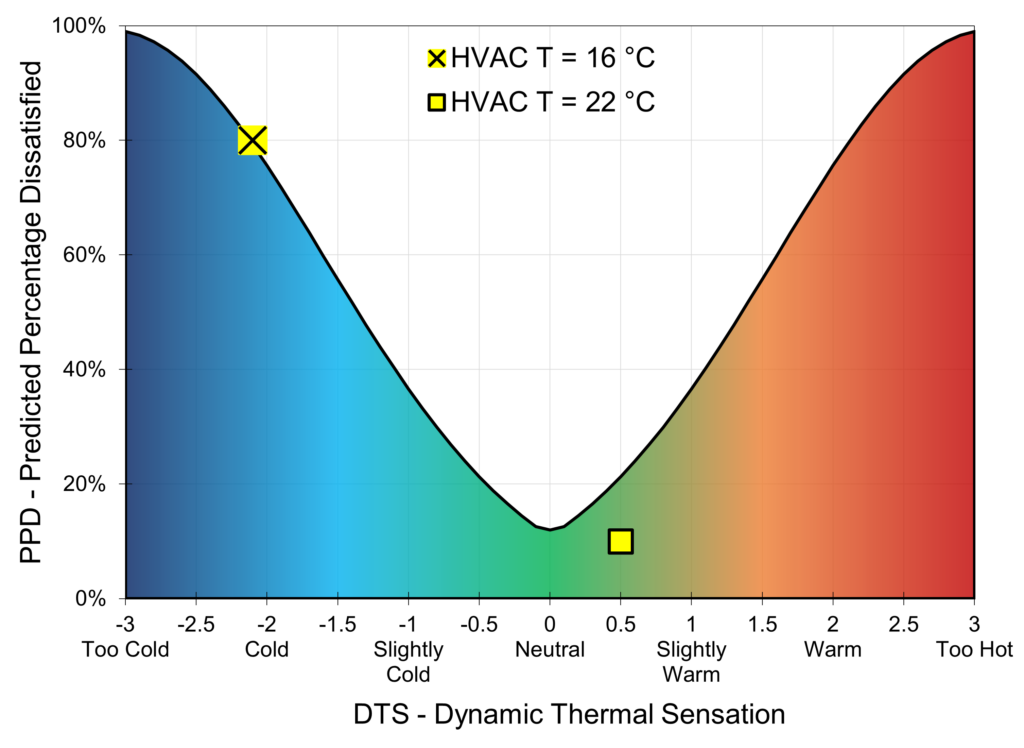
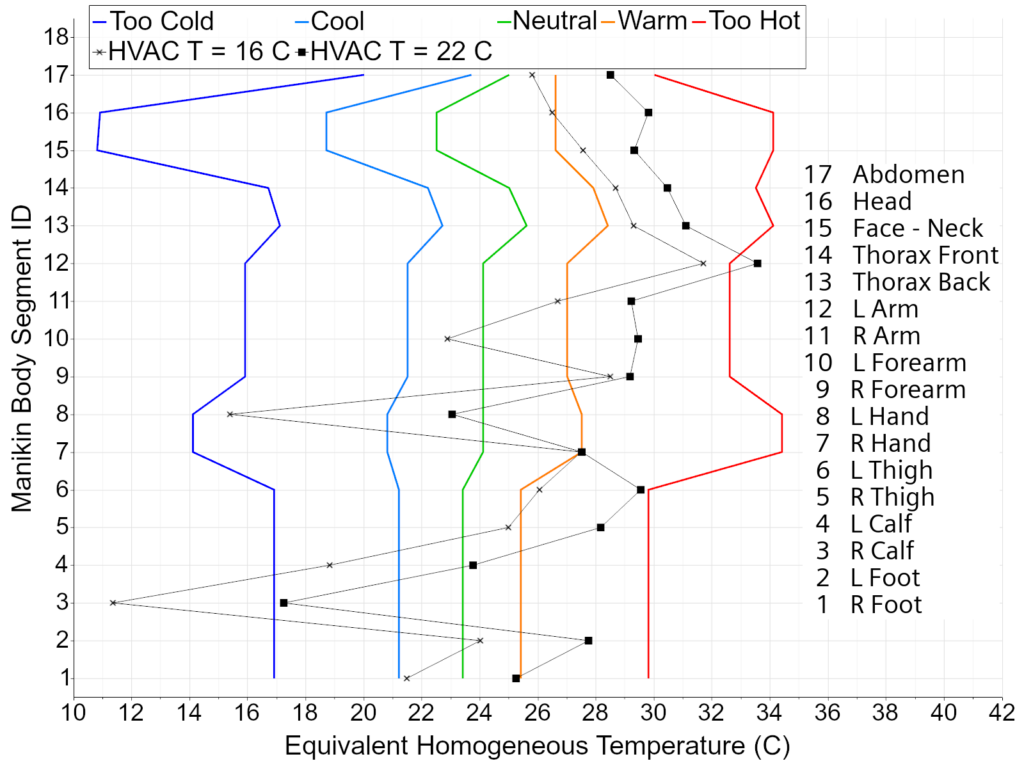
Global refers to the fact that a single index is given to quantify the comfort of the passenger, while a local model provides a more detailed comfort diagram (see right-side graph) where an index is computed for each body part.
These models (DTS, PPD and EHT) take as input the solutions provided by the Fiala heat and thermoregulation model and compute the comfort indexes. DTS is a dimensionless number that follows the 7-point scale proposed by the ASHRAE standards. A negative DTS (-3.0 to -1.0) indicates that the manikin is feeling cold, and vice versa if positive. A value close to zero indicates that the passenger feels comfortable. The PPD is a statistical index and provides an estimate of the percentage of people that would feel dissatisfied under the given condition. Also in this case, the closer to 0%, the higher chances that the passenger(s) are feeling comfortable.
The local EHT indexes are physical temperatures instead. They determine the degree to which the relevant body parts are within acceptable levels of heat loss. Higher values indicate lower heat losses, whereas lower values indicate higher heat losses. The relationship between local EHT values and the perceived thermal sensation was determined with measurements on subjects tested for 1 h under a variety of thermal conditions. Said measurements were made as part of the DIN EN ISO 14505 standard which make the EHT(s) a widely accepted measure of comfort across many industries (Rommelfanger et al.).
LegAC of an HVAC engineer – How cool is too cool?
With all these great new models at my disposal, I couldn’t help but giving them a try on one of our electric vehicle (EV) passenger car cabin geometries. The electrification era (E-era) we live in has brought numerous and highly complex challenges to automotive engineers. These span from handling of restless Li-ions’ souls swimming in a fishbowl (semi-cit.), to invisible yet unbearable high pitched daemons and ultimately down to its majesty, the first law of thermodynamics (aka, energy management).
Independently of how hyped, flamboyant, or geeky-feature-packed modern EVs might be, they all go through a cycle where each kilowatt-hour of chemical energy stored in the battery is converted to kinetic energy and heat, until there is nothing left to convert any more. As shown in multiple studies (i.e., Buhmann et al.), one of the most important specs that can make or break an EV purchase for the average consumer is the real-world range. This implies that OEMs must design vehicles that feature the smartest possible energy management strategy to make the best use of each and every kilowatt-hour of chemical energy. Cabin comfort studies have become a key part of this challenge since the Heating, Ventilation and Air Conditioning (HVAC) may draw a significant amount of energy to keep passengers in a comfortable state.
As a first try, inspired by my Texas trip, I considered a steady-state summer scenario (outside temperature of 38 C – 100 F) and simulated multiple HVAC temperatures (16 C – 26 C) at 85% fan speed (mass flow rate of 0.04 kg/s).
Effects of the solar radiation, as well as the forced convention from the air vents are clearly captured by the Fiala heat and thermoregulation model as well as by the various comfort indexes. Under these conditions, the dynamic thermal sensation and the predicted percentage dissatisfied suggest that an HVAC temperature of 22 C is the optimal compromise between overall comfort and energy expenditure. This is under the assumption that HVAC energy cost increases with an increasing temperature difference between outside air and A/C air.
Furthermore, thanks to the detailed comfort diagram provided by the EHT model, I could clearly see that the positioning and mass flow rate of the floor vent cause a noticeable discomfort of the right foot and lower leg of the driver. This series of tests also taught me that myself and my not-so-talkative manikin friend in the simulation actually have something in common. Our mind conditions are aligned on the fact that sitting in an EV cabin (or a Texan office) in summer with the A/C set to 16 C may very likely result in an uncomfortable state.
Winter is coming – The ultimate balancing act
Given the confidence gained with the models (and with my manikin friend) thus far, I decided to set up a more complex set of cases assuming a winter scenario.
According to numerous studies (i.e., Leoncini et. al) winter is by far the most challenging condition for the Vehicle Thermal Management System (VTMS) of EVs. Compared to internal combustion engine (ICE) powered vehicles that can benefit from massive amounts of waste heat, cabin heat-up of EVs can only come from the good will of the VTMS and the battery of course. Furthermore, additional amounts of energy have to be spent to heat up the battery pack itself if the temperature drops below freezing, to avoid potentially catastrophic failures. Iora et al. found that the auxiliary power required for cabin and battery heating during winter may reduce vehicle range by as high as 44%. A deep analysis of real-world available data (of nearly 200 EVs) published by Hao et al. also showed that when the ambient temperature is lower than 10 C, the electric consumption of the battery increases by 2.3 kWh/100 km for every 5 degrees C change in ambient temperature.
Such figures clearly describe how intricate the balancing act HVAC engineers are faced with really is. To address the comfort part of the problem, OEMs are exploring the usage of strategically placed radiant heat panels, in addition to the traditional A/C and heated seats/steering wheel solutions. Such electric heaters are meant to provide localized heat to reduce the A/C energy expenditure and optimize passenger comfort locally quicker (remember the very cold right calf of my manikin friend?).
To replicate such a scenario, I set up a case with an outside temperature of -15 C (5 F) and no solar loads. In the first case I only tested the effects of the A/C (set to 27 C) and then sequentially added the heated seats (at 50 W), the heated steering wheel (15 W) and ultimately radiant heat panels (30W).
The bottom line: To heat-up or not to heat-up
Overall, data clearly suggest that the E-era has brought enough intricacies to keep HVAC engineers up at night. The balancing act between EV’s range, thermal comfort, battery pack health, safety and cost of the VTMS is currently one of the hardest problems to be solved by OEMs around the world.
On the plus side, Simcenter STAR-CCM+ 2310 enables (not just HVAC) engineers to incorporate all these complex aspects in one single and fully automatable workflow.
In the meantime, choose wisely between how warm you want your bottom to be vs. how likely you are to make it back home. Both HVAC engineers and my quiet manikin friend trust your judgement.

To learn more about the many other new features, including a showcase of creating a Reduced Order Model from such thermal Cabin Comfort CFD simulations, check out the Simcenter STAR-CCM+ 2310 Release Highlights blog.

